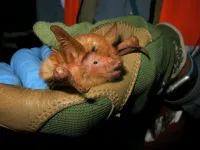(Press-News.org) A group of scientists led by the American Museum of Natural History and Bat Conservation International have discovered a new species of a striking orange and black bat in a mountain range in West Africa. The species, which the researchers expect is likely critically endangered, underscores the importance of sub-Saharan "sky islands" to bat diversity. The species is described today in the journal American Museum Novitates.
"In an age of extinction, a discovery like this offers a glimmer of hope," said Winifred Frick, chief scientist at Bat Conservation International and an associate research professor at the University of California, Santa Cruz. "It's a spectacular animal. It has this bright-orange fur, and because it was so distinct, that led us to realize it was not described before. Discovering a new mammal is rare. It has been a dream of mine since I was a child."
In 2018, Frick and her colleagues at Bat Conservation International and the University of Maroua in Cameroon were in the Nimba Mountains in Guinea conducting field surveys in natural caves and mining tunnels, known as adits, that were built in the 1970s and 1980s and have since been colonized by bats. In collaboration with the local mining company, Société des Mines de Fer de Guinée (SMFG), the scientists are trying to understand which bat species use which adits and at what times of the year. Of particular interest is Lamotte's roundleaf bat, Hipposideros lamottei, which is listed by the International Union for Conservation of Nature (IUCN) as critically endangered and has only ever been recorded in the Nimba Mountains. Much of its known population lives in the adits, which are in different states of collapse and will disappear in time. While surveying for this bat, the researchers found something peculiar--a bat that looked nothing like Lamotte's roundleaf bat and did not match the descriptions of any other species that they knew occurred in the area. Later that night, they called on American Museum of Natural History Curator Nancy Simmons, a bat expert and chair of the Museum's Department of Mammalogy, for help.
"As soon as I looked at it, I agreed that it was something new," said Simmons, the lead author of the paper and Bat Conservation International Board member. "Then began the long path of documentation and gathering all the data needed to show that it's indeed unlike any other known species."
Through morphological, mor¬phometric, echolocation, and genetic data, including comparative data from collections at the Museum, the Smithsonian National Museum of Natural History, and the British Museum, the scientists described the new species, which they named Myotis nimbaensis ("from Nimba") in recognition of the mountain range in which it is found. A chain of "African sky islands," the Nimba Mountains have peaks rising between 1,600-1,750 meters (about 1 mile) above sea level and are surrounded by drastically different lowland habitats. As such, they are home to exceptional biodiversity, including bats.
"In addition to the Lamotte's roundleaf bat, it's possible Myotis nimbaensis could be the second bat species found only in this particular mountain range," said Jon Flanders, Bat Conservation International's director of endangered species interventions.
This study is part of an ongoing effort critical in helping the Nimba Mountain bats survive. Bat Conservation International and SMFG have already started working together to build new tunnels, reinforced to last for centuries and in habitat away from the mining project, for the Lamotte's roundleaf bat. And although little is known yet about the population and range of Myotis nimbaensis, efforts like this will likely help it as well.
INFORMATION:
Other authors on the study include Eric Moïse Bakwo Fils from the University of Maroua; Guy Parker, Jamison Suter, and Seinan Bamba from SMFG; Mory Douno from the Ministry of the Environment, Water, and Forests in Guinea; Mamady Kobele Keita from Guinée Ecologie; and Ariadna Morales from the American Museum of Natural History and the Max Planck Institute of Molecular Cell Biology and Genetics, Dresden, Germany.
Link to study: http://digitallibrary.amnh.org/handle/2246/7249
ABOUT THE AMERICAN MUSEUM OF NATURAL HISTORY (AMNH)
The American Museum of Natural History, founded in 1869 and currently celebrating its 150th anniversary, is one of the world's preeminent scientific, educational, and cultural institutions. The Museum encompasses more than 40 permanent exhibition halls, including those in the Rose Center for Earth and Space, as well as galleries for temporary exhibitions. The Museum's approximately 200 scientists draw on a world-class research collection of more than 34 million artifacts and specimens, some of which are billions of years old, and on one of the largest natural history libraries in the world. Through its Richard Gilder Graduate School, the Museum grants the Ph.D. degree in Comparative Biology and the Master of Arts in Teaching (MAT) degree, the only such free-standing, degree-granting programs at any museum in the United States. The Museum's website, digital videos, and apps for mobile devices bring its collections, exhibitions, and educational programs to millions around the world. Visit amnh.org for more information.
About Bat Conservation International
Founded in 1982, Bat Conservation International has grown into a global conservation organization dedicated to ending bat extinctions. Working together, our goal is to redefine what is possible in global conservation, through the utilization of cutting-edge tools, technology, and training to create a real, measurable impact. For more information, visit batcon.org.
With the impact of climate change increasing by the day, scientists are studying the ways in which human behavior contributes to the damage. A recent study at Walla Walla University, by a collaboration of researchers from Walla Walla University and La Sierra University, examined the effects of acidic water on octopuses, potentially bringing new insight into both how our activities impact the world around us, and the way that world is adapting in response.
The study, "Impact of Short- and Long-Term Exposure to Elevated Seawater PCO2 on Metabolic Rate ...
The human organism requires a variety of small molecules, such as sugars or fats, in order to function properly. The composition of these so-called metabolites and their interaction - the metabolism - varies from person to person and is dependent not only on external influences, such as nutrition, but also to a significant extent on natural variations in our genetic make-up. In an international study, scientists from the Berlin Institute of Health (BIH) and Charité - Universitätsmedizin Berlin joined forces with colleagues from the United Kingdom, Australia and the United States and discovered hundreds ...
A new study from UBC researchers suggests a strong correlation between following the MIND and Mediterranean diets and later onset of Parkinson's disease (PD). While researchers have long known of neuroprotective effects of the MIND diet for diseases like Alzheimer's and dementia, this study is the first to suggest a link between this diet and brain health for Parkinson's disease (PD).
The MIND diet combines aspects of two very popular diets, the Mediterranean diet and the Dietary Approaches to Stop Hypertension (DASH) diet.
"The study shows individuals with Parkinson's disease have a significantly later age of onset if their eating pattern closely aligns with the Mediterranean-type diet. The difference shown in the study was up to 17 years later in women and eight years later ...
There are things in life that can be predicted reasonably well. The tides rise and fall. The moon waxes and wanes. A billiard ball bounces around a table according to orderly geometry.
And then there are things that defy easy prediction: The hurricane that changes direction without warning. The splashing of water in a fountain. The graceful disorder of branches growing from a tree.
These phenomena and others like them can be described as chaotic systems, and are notable for exhibiting behavior that is predictable at first, but grows increasingly random with time.
Because of the large role that chaotic systems play in the world around us, scientists and mathematicians have long sought to better understand them. Now, Caltech's Lihong Wang, the Bren Professor in the Andrew and ...
CORVALLIS, Ore. -- A recent study from Oregon State University found that after Oregon expanded Medicaid in 2014, more women were able to receive insurance coverage for abortion services, rather than paying out of pocket.
In analyzing Medicaid claims data and other medical records, researchers found that the Medicaid-financed share of total abortions increased each of the first three years following the state's Medicaid expansion. The incidence of Medicaid-financed abortions increased 18% in 2014, then 7% each in 2015 and 2016.
The total number of abortions in the state did not rise; rather, the expansion shifted who paid for them.
"According to the literature, there was a 1% decline in the abortion rate in Oregon between 2014 and 2017. During the pre-expansion ...
As marijuana outlets open after the drug is legalized, the density of those recreational retailers is associated with more use and a greater intensity of use among young adults, according to a new RAND Corporation study.
The study is among the first to examine associations between the density of marijuana outlets and marijuana use over time, and is the first to include unlicensed dispensaries in such an analysis.
Studying young adults in Los Angeles County the year before and the year after marijuana was available for recreational purchase in ...
TROY, N.Y. -- Blood sample analysis showed that, two to five years after they gave birth, mothers of children with autism spectrum disorder (ASD) had several significantly different metabolite levels compared to mothers of typically developing children. That's according to new research recently published in BMC Pediatrics by a multidisciplinary team from Rensselaer Polytechnic Institute, Arizona State University, and the Mayo Clinic.
Researchers analyzed blood samples from 30 mothers whose young children had been diagnosed with ASD and 29 mothers of typically developing children. At the time that the samples were taken, the women's children were between 2 and 5 years old. The team found differences in several metabolite levels between the two groups of mothers. ...
Research led by the University of Wyoming shows that physical weathering is far more important than previously recognized in the breakdown of rock in mountain landscapes. Because it is difficult to measure, physical weathering has commonly been assumed to be negligible in previous studies.
Cliff Riebe, a professor in UW's Department of Geology and Geophysics, headed a research group that discovered that climate and erosion rates strongly regulate the relative importance of subsurface physical and chemical weathering of saprolite, the zone of weathered rock that retains the relative positions of mineral grains of the parent bedrock and lies between ...
A compound developed at Oregon Health & Science University appears to protect nerve fibers and the fatty sheath, called myelin, that covers nerve cells in the brain and spinal cord.
The discovery, published in the Journal of Neuroimmunology, could be important in treating or preventing the progression of multiple sclerosis and other central nervous system disorders. The new research in a mouse model advances earlier work to develop the compound - known as sobetirome - that has already showed promise in stimulating the repair of myelin.
"Sobetirome and related drugs are effective at stimulating myelin repair after damage has occurred. Our new findings now suggest that these drugs could also prove ...
Earth gets blasted by mild short gamma-ray bursts (GRBs) most days. But sometimes a giant flare like GRB 200415A arrives at our galaxy, sweeping along energy that dwarfs our sun. In fact, the most powerful explosions in the universe are gamma-ray bursts.
Now scientists have shown that GRB 200415A came from another possible source for short GRBs. It erupted from a very rare, powerful neutron star called a magnetar.
Previous detected GRB's came from relatively far away from our home galaxy the Milky Way. But this one was from much closer to home, in cosmic terms.
GRB explosions can disrupt mobile phone reception on earth, but they can also be messengers from ...



